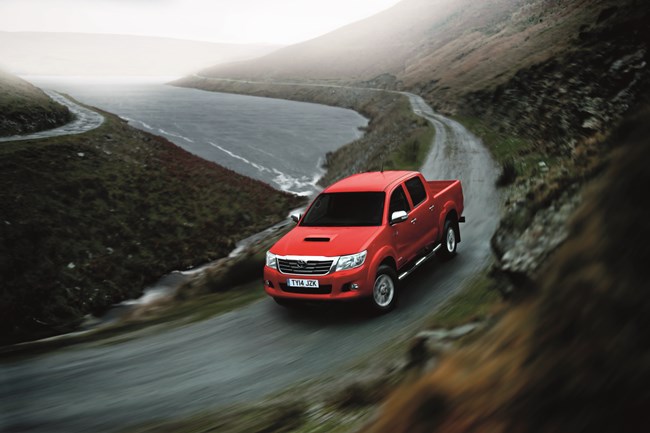- ETRUX launches new Ford E-Transit Trizone
- Renault gives UK debut to Master E-Tech at CV Show
- Isuzu D-Max long-term test – Latest Report
- Isuzu D-Max V-Cross Steel Edition revealed
- IVOTY Report: Stellantis explores the hydrogen proposition
- New Maxus EVs include eDeliver 5 van
- Used LCV values reach six-month high
- ADVERTISEMENT FEATURE: IVECO Daily Mission Awards 2024 Q2 Round-up: Grounds Maintenance & Forestry
- Stellantis Pro One electric vans review
- Mitie adds 5,000th EV to fleet
Buying a used... Toyota Hilux (2015)
Date: Thursday, April 7, 2022 | Author: Ian Shaw
If you want toughness and tenacity, or just remember Tonka and Tamiya toys, the Hilux is for you.

In the UK we sit in a sort of pick-up hinterland. To the west is North America: home of the pick-up, where Ford will have sold another F-series by the time you have reached the end of this sentence. To the east, Japanese brands, built in Thai factories, are equally prolific. In the UK we were happy enough with the truck cab Land Rover. Then, Toyota, known on these shores for tiny, – and indeed slightly tinny – reliable saloons, unleashed the Hilux, and everything changed. It was relatively cheap and relatively simple; tough yet comfortable, substantial though lacking substance. From 1968 the Hilux gradually carved an expanding niche for itself through seven versions, until the eighth generation of 2015 appeared with a facelift in 2020. It is this incarnation to which we turn our gaze.
This might not seem like a prelude to recommendation, but the Hilux has seldom been the best in any one area. Not the best payload, largest load bed, most powerful engine or the most versatile 4WD system. In a similar manner to a driver winning the Formula One championship without winning a single race, the Hilux has amassed enough points to succeed.
At 5,330mm long, 1,855mm wide and 1,810mm high, it is compact enough for residential streets and farm tracks alike; with a wheelbase just over 3.0m it hits the compromise between off-road ability and on-road civility pretty well too. The cab type affects the load length, the most popular double- cab offers 1.52m, the pleasingly unusual extra-cab some 1.8m and the rare single-cab just over 2.3m. All have a bed that is 1.64m wide with sides of almost 500cm.
Payloads peak at 1,300kg for a basic single-cab, hover around 1,200kg for an extra-cab and drop to a VAT-reclaimable 1,050kg on a double-cab.
The Hilux has always felt a bit underpowered through its life but the 2015 version’s 3.0L diesel certainly had some punch and it is still impressive. The later 2020 facelift brought in a 2.8L that finally gave the Hilux the power it deserved with 204hp and 500Nm of torque, with the six-speed automatic transmission. Choose a manual box and you get 420Nm, but it is the better combination to drive. The 2.4L is a bit lacking at 150hp and its economy hardly compensates, officially 27mpg versus 33mpg, but you will drive the 2.4L harder. To utilise the generous 3,500kg towing capacity (3,200kg for double-cabs) the 2.8L is a boon.
The workhorse specification Active version has steel wheels and a mechanical locking rear differential; the Icon adds active rear differential, a reversing camera and alloys, while the Invincible adds parking sensors, keyless entry and heated seats. The Invincible X is only about show. They all have one thing as standard, however. A thoroughly deserved reputation for hard work. It might not be the best in any one field, but it is the best across all fields.
Five best options
1) Icon trim
2) Invincible trim
3) 3.0L engine
4) 2.8L engine
5) Toyota special editions
Five best avoided
1) Active trim
2) Invincible-X trim
3) Automatic transmission
4) Individual dealer specials
5) Non-Toyota additions
Second-hand buys
|
Version |
Plate |
Year |
Mileage |
Price ex.VAT |
|
3.0 D4-D Invincible D-cab |
65 |
2015 |
56,000 |
£21,495 |
|
3.0 D4-D Invincible D-cab |
17 |
2017 |
51,100 |
£24,950 |
|
2.4 D4-D Invincible D-cab |
19 |
2019 |
35,500 |
£28,495 |
|
2.4 D4-D Invincible D-cab |
70 |
2020 |
4,500 |
£34,995 |
|
2.8 D4-D Invincible D-cab |
71 |
2022 |
50 |
£39,000 |
View The WhatVan Digital Edition


